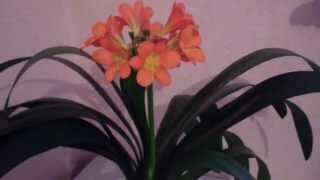Cleavage flower is an excellent ornamental and flowering plant, characterized by its simple beauty. He is able to decorate the room at any time of the year, but this flower is especially admirable during flowering, that is, in the winter months. Large and bright inflorescences transform the plant and fill the room with spring and orange-yellow mood. Of all the existing varieties of this plant, a cinnabar cleavage is successfully grown at home. It can be up to 45 meters in height with leaves no longer than half a meter.
Home care for cleansing
Cleavage flower owners care for this plant will not cause much trouble. It is enough to observe simple rules, which consist in moderate humidity, light exposure and the presence of a rest period.
Clevia: lighting
Ideal for the cleavage is diffused light. Such lighting can be obtained on the east or west window. However, if there is no such place in the apartment, the plant can also be placed on the south side, however, it must be pritenyat. In the summer months, the clivia can be exposed to the open air, while choosing penumbra.
Cleavage: humidity
Air and ground humidity do not play a big role for the cleavage. The optimum will be moderate watering, which allows a small drying of the soil. It is necessary to avoid overmoistening of the soil, otherwise the roots of the plant can be rotten. If you still can not avoid wetting the soil - in this case, you should transplant the clove into the pot with soil for orchids, which positively affects the condition of the cleft. Ideally, the Cleivia leaves should be wiped with a damp cloth, but this procedure can be successfully replaced by periodic bathing under the shower, but try not to get water inside the plant's rosette.
Clevia: air temperature
The most suitable air temperature for the clivia is 20-25 degrees during the period of growth and 12-14 degrees with the onset of autumn. Decrease in temperature will provide the plant with a rest period for laying the kidneys. With the advent of the peduncle, the temperature should be raised again to 18-20 degrees. The larger the size and age of the plant, the longer it should have a rest period.
Cleavage: fertilizing with fertilizers
Regular fertilizing with fertilizers positively affects the growth and general condition of the cleavage. It is best to choose fertilizers for bulbous or flowering plants. Some growers are advised to reduce the concentration indicated in the instruction so as not to give the plant extra fertilizing. You can also use dry fertilizer. For 1 liter of water, you need 2 grams of this mixture.
Klivia: transplant and reproduction
Too frequent transplantation will not only not benefit the Cleavia, but it can also harm it. Fleshy roots of the plant, accumulating water, ensure his life. Damage or breakage of rootlets during transplantation can lead to decay and even death of the plant. That is why it is necessary to put the cleansing in a new pot only in cases of extreme necessity, for example, when the old pot became too small. It is desirable to sprinkle roots of broken roots with pounded activated carbon or ash.
You can propagate the cleavage with babies or seeds. The first method is considered to be simpler and more common. Babies appear at the plant during growth. For a painless cessation, it is better to wait for the appearance of 4-5 leaves and during the transplantation of an adult plant place the shoots in a new pot. Reproduction of clivia by seeds is a longer process. Seeds can be purchased at the store or obtained independently, by pollinating the plant during the flowering period. After placing seeds in the seedling shoot, wait about 6 weeks later.
Cleavia: illnesses and problem points
Despite sufficient ease of care, some problems of growing a cleavage can still arise:
- The lack of flowering of may be due to insufficient lighting, too high temperature or a short rest period.
- The short flower spike of can be the result of insufficient irrigation.
- White spots on the leaves of appear most often as a result of sunburn.
- Rotting of the roots of is due to overmoistening of the soil.
- Curved leaves, withering and falling , indicate the appearance of a mealybug. To save the plant you can wipe the leaves with a soap solution and bathing under a warm shower.
- If brown spots of appear on the surface of the leaves, which can be removed with a fingernail, this may indicate the attack of the scab. The action plan does not change in this case, however, after the shower, 0.15% treatment is required. For both diseases, the damaged parts of the plant must be removed.
- If the cervix begins to appear dark spots around which a yellow area forms and gradually dries, and at the ends of the leaves appear dark-brown stains is a fungal disease Anthracnose caused by the fungus Colletotrichum cliviae. Promotes the development of the disease warm wet conditions. It is treated with a systemic fungicide or copper chloride( with the drug HOM).The plant is reduced by watering, airing the room, canceling the spraying for several weeks, and the damaged leaves are removed and burned.
Video:
 6:02
6:02  2:14
2:14  1:46
1:46 